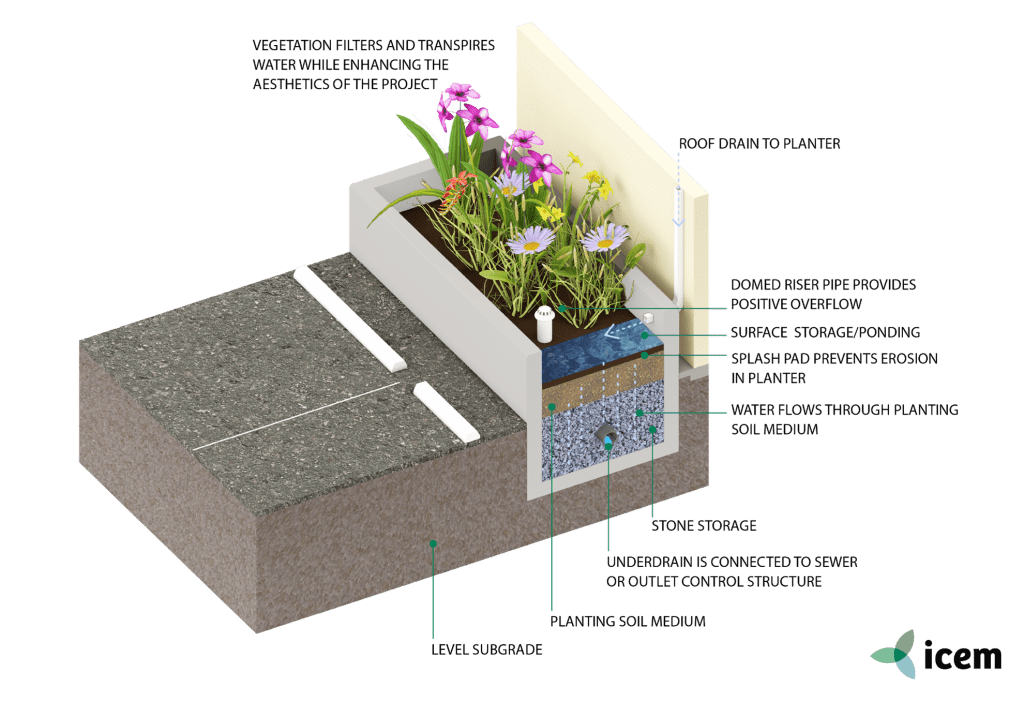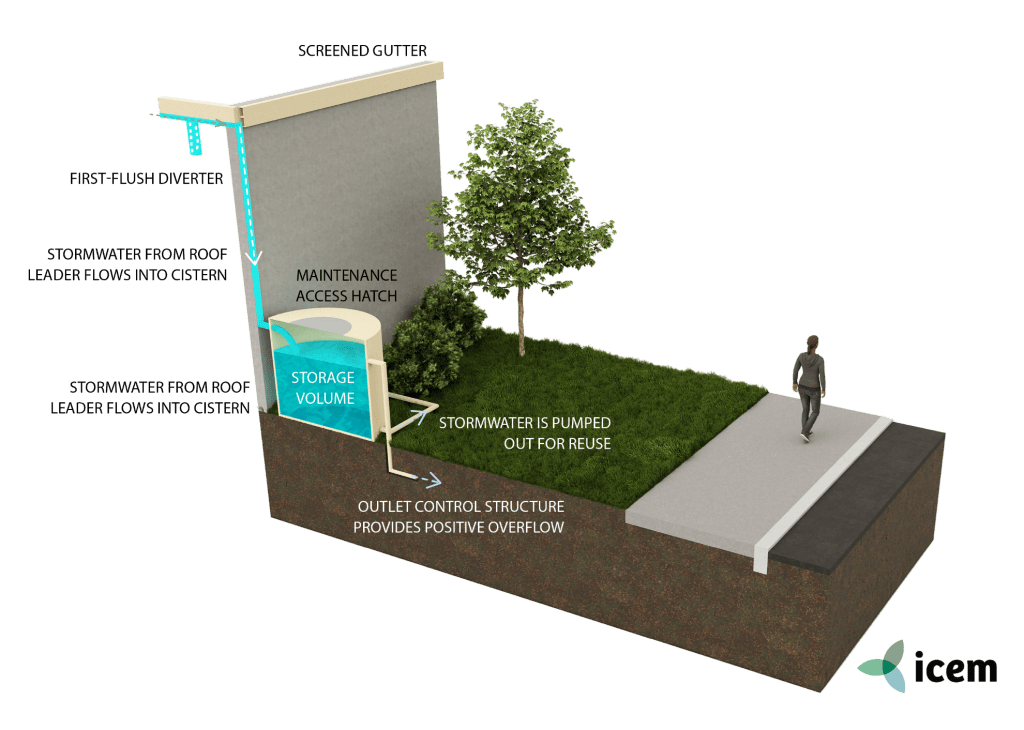| Suburban and urban | Building, Public Spaces, and Streets | Medium-cost | Fluvial flooding | |
| DESCRIPTION | |
| Measures
|
Stormwater harvesting schemes are designed to capture and store stormwater for reuse for a range of demands which will reduce potable water use. By capturing and storing stormwater the volume entering downstream waterways is reduced. They have the greatest impact on reducing flow volumes associated with frequent flow events. Stormwater harvesting schemes are typically located at the end of a treatment train and benefit downstream environments by ensuring a large portion of stormwater and its associated pollutant loads do not enter the receiving waters. Stormwater harvesting can be used to:
● Manage the first 2.5 centimeters of rainfall on-site in part or whole depending on the tank size; ● Reduce pollutant loads to meet water-quality targets; ● Retrofit existing developed areas. |
| Location | Stormwater harvesting is very appropriate in many locations in urban environments as they ensure a large portion of stormwater and its associated pollutant loads do not enter the stormwater network. Open water storages provide local microclimate benefits by keeping water in the landscape. The storage and re-use of water help to address downstream flooding and the water harvested can be reused for irrigation or green leisure spaces and provides local microclimate benefits by keeping water in the soil and enhancing the process of evapotranspiration. |
| Design options and performance | The design of stormwater harvesting and re-use infrastructure will differ significantly as they can range from fabricated metal tanks to concrete tanks through to open water bodies. Sizing will depend on the rainfall, catchment, and demand but stormwater harvesting tanks should be sized to deliver between 70–80% reliability. Optimal sizing of the storage is site-specific, but a water balance assessment should be carried out including the main supply and demand requirements. To reduce pumping and infrastructure costs, the demand area should not extend beyond 2 km from the point of supply. When deciding on the appropriate design for the stormwater harvesting system the following should be considered:
● Required storage for buffering ● Demand volume ● Distribution requirements including pumping requirements if needed ● Required water quality of stormwater and additional treatment required based on the risk of end use ● Operational and maintenance costs of infrastructure including pumps Open water storage design will need to consider the ground conditions including the level of bedrock and water table and consider space constraints including making allowance for the side slopes. |
| Feasibility criteria
|
Rainwater is collected from a building or other paved surfaces in an over-ground or underground tank for use on-site. Depending on its intended use, the system may include treatment elements. The system should include specific storage provisions if it is to be used to manage runoff to a design standard Runoff from urban areas and runoff from pedestrian areas will require limited treatment. Treatment usually is achievable using soil or gravel filtration media systems (e.g., pervious pavement, tree pits, bioretention systems) or through the use of planted conveyance and storage zones (e.g., swales, wetlands/ponds).
Pre-treatment: The following additional design criteria apply to pre-treatment components of the harvesting system. For larger tank systems, the initial first flush must be diverted from the system rainwater enters the storage tank. The term “first flush diversion” is used to distinguish it from the traditional stormwater management term “first flush.” The amount can range from the first 0.5 millimeters to 1.5 millimeters of roads and roof runoff. The first flush diverter direct includes the initial pulse of rainfall away from the storage tank. While leaf screens effectively remove larger debris such as leaves, twigs and blooms from harvested rainwater. On-site treatment in a secondary practice: The basic approach is to provide a dedicated secondary runoff reduction practice on-site that will ensure water within the tank will gradually be drawn down at a specific design rate between storm events. Secondary runoff reduction practices may include the following: ● Impervious surface disconnection ● Vegetated filter strip ● Grass swales ● Infiltration and micro-infiltration ● Water quality swale, rain garden or urban bioretention Raingarden: A rain garden is a planted depression designed to infiltrate stormwater runoff but not hold it. Rain gardens are planted basins that increase infiltration of run-off into the ground; improving water quality by removing pollutants from run-off in the range of 40% to 97% has been well documented. The performance of infiltration systems is dependent on the infiltration capacity of the surrounding soils and the depth of groundwater. Watershed runoff area: Max. watershed runoff area is 2 ha with an average rain garden dimension of 3000 m2, which allow for adequate irrigation between small storm events. Rain gardens should be located at least 3 meters from buildings to prevent water outflow into foundations or underneath houses, causing mold issues. Also, a location away from large trees allows exposure to sunlight so that rain gardens may dry out between storm events. Dense vegetation such as shrubs also minimizes the risk of clogging surface soils. Technical design: The design process should take into consideration the following: ● End-use requirements for the harvested water in terms of water quality and quantity ● The reliability of supply including the design frequency and average duration of periods when there will be no supply ● The need to minimize their risks to public health and the environment by; (i) providing appropriate treatment for the stormwater, (ii) (minimizing mosquito habitat for open storage (iii) minimizing contamination of water after it receives final treatment, (iv)minimizing public exposure to untreated stormwater and (v) minimizing cross-contamination with mains water distribution networks or public confusion with mains water supplies (vi)balancing the need to extract sufficient water to meet the end-use requirements while also providing an adequate supply for downstream aquatic ecosystems (vii) potentially stopping collection if stormwater is contaminated by an incident within the catchment (viii) minimizing the risk and/or impact of upstream flooding. Soil media: n/a Soil slope: n/a Surface cover: n/a Materials: depends upon design but generally includes channels and pipework for capturing the runoff and conveying it to the storage, storage (either storage tanks or open storage ponds), filtration treatment facility plus any other additional treatment needed and distribution network for end use |
| Operation and maintenance | Storage tanks will need annual maintenance and open storage ponds will need regular cleaning and removal of vegetation. Maintenance is only related to the regular inspection and cleaning of the catchment, gutters, filters, and tanks to reduce the likelihood of contamination. Raingarden systems require regular maintenance to ensure continuous operation to design performance standards. Regular inspection and maintenance are required to prevent clogging by sediment and debris. Rain gardens should be located in sunny areas to dry out between rain events. |
| Cost and benefits | Medium to high-cost measure. Stormwater harvesting schemes result in several benefits including:
● Provision of additional water for a variety of uses which would otherwise be supplied by the water utility. ● Reduction in the cost of water that needs to be purchased from the utility company. These schemes are very beneficial in large buildings or buildings with large roofs such as schools and leisure centers. ● Stormwater retention and attenuation is improved, especially in an urban environment where any water that is captured and retained on-site will reduce the volume of water discharged into the main drainage system thus reducing the flood risk. ● Stormwater harvesting schemes are environmentally friendly since a filtration process is used for treatment which does not require the addition of chemicals. |
| Design solution | Stormwater harvesting is the process of collecting and storing rainwater, rather than allowing it to run off. Rainwater can be collected from any flat non-polluted surface and redirected to storage tanks, either above ground or underground and then be used for any non-potable purpose such as for toilet facilities laundries, irrigation and production, thus lowering demand on the supply from the public water utility. Smaller systems may only involve individual houses but larger systems can be constructed for schools, hospitals, and commercial or industrial units and need to be financed by owners, organizations, and the government. |
| Environmental performance | Rainwater harvesting has the following environmental benefits:
● Water treatment and pumping make up a high percentage of municipal energy consumption so stormwater harvesting systems provide an alternative water supply and therefore help to minimize the need for new infrastructure projects and reduce this energy usage; ● By reducing stormwater runoff, rainwater harvesting can reduce a storm’s peak flow volume and velocity in local streams and rivers, thereby reducing the potential for streambank erosion; ● Stormwater harvesting systems can contribute to municipalities overall stormwater management program to prevent erosion, flooding, and poor water quality in lakes and streams; ● In urban settings, up to 90% of water runs off because of all the hard surfaces like roads, parking lots, and roofs whereas, in nature, up to 90% soaks into the ground. Rainwater systems counteract stormwater runoff and thereby reduce flooding, erosion, and groundwater contamination. When combined with infiltration designs like rain gardens, a natural state can be regained. ● Stormwater harvesting helps to maintain the water cycle and plays an important part in helping cities to become green. ● As opposed to using well water which depletes groundwater resources, using stormwater harvesting for irrigation helps to replenish groundwater supplies. |
| Sources | ● CIRIA. 2015. The SuDS Manual. Chapter 11, Rainwater Harvesting.
● Global Development Research Centre, not dated. An introduction to rainwater harvesting. ● IVWater Solutions. 2019. Stormwater Harvesting: Good Maintenance Practice. ● Pennsylvania Stormwater. 2006. Best Practice Manual. |
Originally developed under the ADB ‘TA-9417 VIE: Secondary Green Cities Development Project – Output 2: Demonstrated sustainable and resilient development in Hue, Ha Giang and Vinh Yen’. Adapted for the UN-CTCN project ‘Climate risk assessment for subnational adaptation and establishment of a local climate information system for climate change adaptation (LISA) in Cambodia’.




